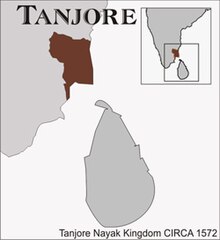Raghunathabhyudayam

The Raghunāthābhyudayam (or Raghunāthā-bhyudayam, Raghunāthābhyudaya, Ragunatha Abhyudaya) by Rāmabhadrāmbā, one of the wives of the Thanjavur Nayak king Raghunatha Nayak (r. 1600-34), is a Sanskrit mahākāvya in twelve cantos. It was designed to valorise Raghunatha, situating his career as a type of the life of epic Rāma-Viṣṇu-Kṛṣṇa.[1]
The first few cantos of the poem invoke Raghunatha, seeking his patronage and assistance, and praise his generosity, piety, and intellect. Canto 4 presents Raghunatha's ancestry and the subsequent cantos discuss his early life and military successes. He succeeds his father Achuthappa Nayak in canto 8 and continues with his military exploits. The last two cantos focus on the cultural activities and artistic achievements of his court, with a colophon in which Rāmabhadrāmbā emphasises her own merits.
The poem was first brought to scholarly attention by S. Krishnaswami Ayyangar in 1919, after he found it in November 1916.[2] The poem was fiercely criticised by an early reviewer of the first scholarly edition, who claimed that Rāmabhadrāmbā 'had thoroughly assimilated the art of composing a poem of surpassing tediousness and consisting of the most abject flattery of her royal patron' and did not think the poem would have any interest to historians.[3] But it has since been identified as a significant source for the cultural history of seventeenth-century south India.[4]
Rāmabhadrāmbā's Sanskrit Raghunāthābhyudayam is not to be confused with the identically named Telugu poem the Raghunāthābhyudayam and the similarly named Raghunāthanāyakabhyudayamu, both composed by Raghunatha's eldest son and successor, Vijayarāghava Nāyaka.[5]
Editions and translations
- Rāmabhadrāmbā, 'Raghunāthābhyudayam', in Sources of Vijayanagar History (Selected and Edited for the University), ed. by S. Krishnaswami Ayyangar [and A. Rangaswami Sarasvati], The Madras University Historical Series, 1 (Madras: University of Madras, 1919), pp. 284–302 [no. 91], https://archive.org/details/sourcesofvijayan00krisrich. [Abridged edition and translation.]
- Raghunāthābhyudayamahākāvyam: Rāmabhadrāmbāviracitam, ed. by Ti. Rā. Cintāmaṇiḥ, Bulletins of the Sanskrit Department, University of Madras, 2 ([Madras]: Madrapurīyaviśvavidyālayaḥ, 1934)
References
- ^ Davesh Soneji, Performing Satyabhimi: Text, Context, Memory and Mimesis in Telugu-Speaking South India (unpublished PhD thesis, McGill University 2004), p. 53.
- ^ Rāmabhadrāmbā, 'Raghunāthābhyudayam', in Sources of Vijayanagar History (Selected and Edited for the University), ed. by S. Krishnaswami Ayyangar [and A. Rangaswami Sarasvati], The Madras University Historical Series, 1 (Madras: University of Madras, 1919), pp. 284-302 [no. 91] (p. 284), https://archive.org/details/sourcesofvijayan00krisrich.
- ^ J. C., review of Raghunāthābhyudaya of Rāmabhadrāmbā (A Historical Poem). Edited by T. R. Chintamani. (Bulletins of the Sanskrit Department, No. 2.) pp. viii + 78. University of Madras, 1934. Bulletin of the School of Oriental and African Studies, 7 (1935), 961-62, doi:10.1017/S0041977X00086377
- ^ Velcheru Narayana Rao, and David Shulman, 'History, Biography and Poetry at the Tanjavur Nayaka Court', Social Analysis 25 (1989), 115–130.
- ^ Raghunāthanāyakābhyudayamu and Raghunāthābhyudayamu, ed. by N. Venkataramanayya and M. Somasekhara Sarma, Madras: Government Oriental Series, 49/Tanjore Saraswathi Mahal Series, 32 (Madras, 1951).
